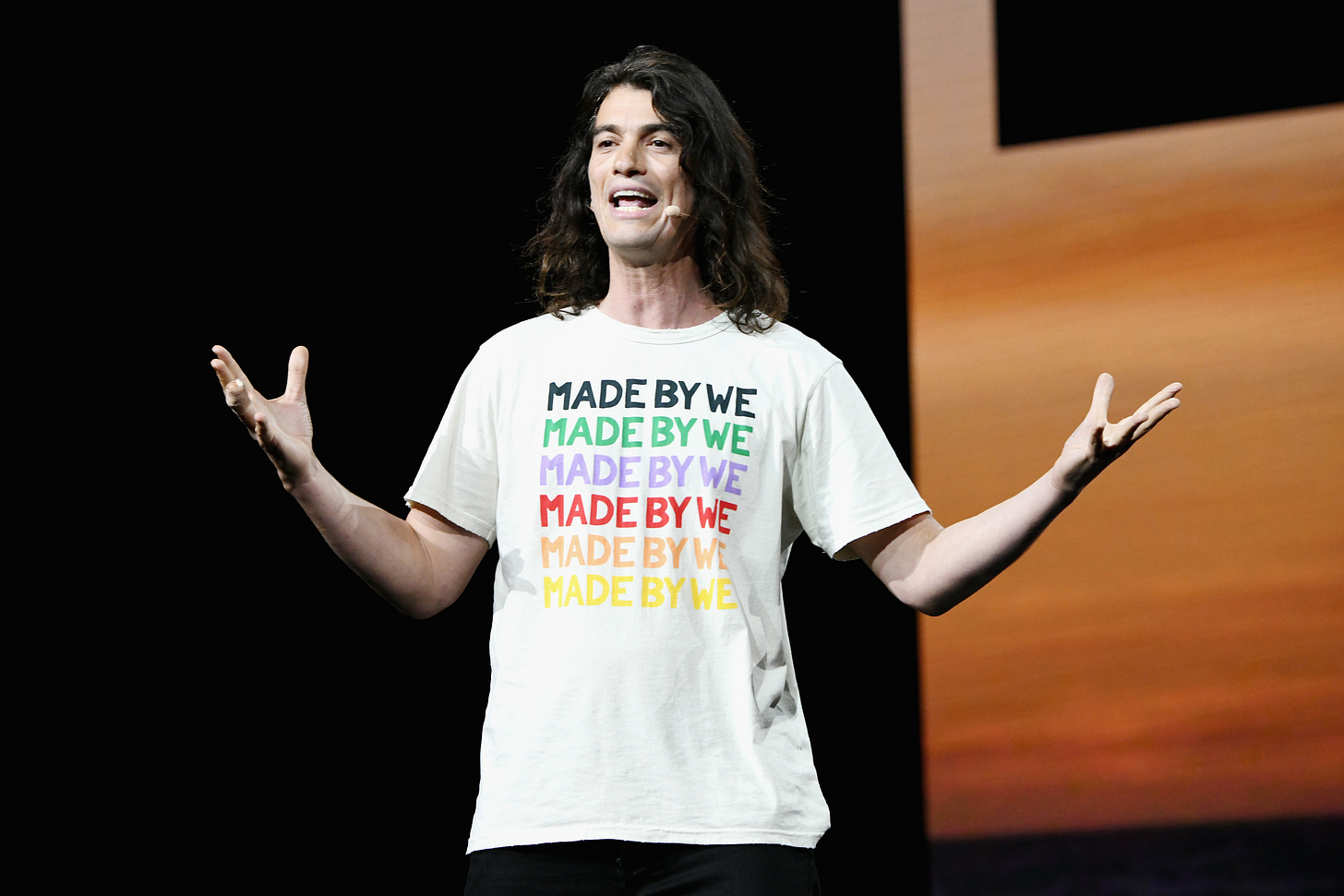Happy Sunday! This weekend I’m thrilled to have a conversation with Wall Street Journal reporter Eliot Brown, co-author of The Cult of We: WeWork and the Great Startup Delusion. Eliot was writing savvy pieces about WeWork before it was cool and is the expert on We. He produced iconic scoops like this one about Adam Neumann’s passion for surfing, or this one about him smoking weed on a transatlantic flight.
Eliot and I chatted about WeWork, Adam, the “chicken first” SoftBank investing philosophy, and of course Andreessen Horowitz’s recent $350 million investment in Neumann’s latest venture, Flow. Interviews like this are typically available exclusively to paid Oversharing subscribers, but since this one is so much fun I decided to make it free. You can listen to the audio or read the transcript, which has been condensed and edited for clarity.
Oversharing: Let’s talk about Adam, who is back in the news because he recently raised $350 million, the biggest check Andreessen Horowitz has ever cut in a single investing round, for a new company called Flow, which is going to redefine the future of residential real estate. But before that, he had a little company called WeWork, which you wrote a book about.
Brown: The rise and fall. Yes, co-wrote, I should say with, with co-author Maureen Farrell.
It’s a great book, I really enjoyed it. I mean, how could you not—what a corporate epic for our time.
They gave us plenty of material.
One thing I’ve always liked about your reporting is that you came at it originally from a background of being a real estate reporter, not a tech reporter.
Yeah, I was actually covering the office market when I first stumbled on WeWork, as you know, a real estate reporter from the real estate beat. And one of the first things that Adam said to me when I met him in 2013 was, ‘Oh, well, why are you covering us? You’re a real estate reporter and this isn’t a real estate story.’
That is sort of the essence of the WeWork pitch, right? Is that WeWork is a tech company, not a real estate company. But I think it’s fair to say that a lot of the thesis of your reporting is that WeWork was a real estate company.
At first I was open to and looked into the idea that Adam was pitching, which is that they were something else. They were representative of some community or there was something going on that was more than just subleasing office space. But then the more I looked into it, and really what had happened was finding out the valuation of WeWork, which took a number of more months, which at the time was $1.5 billion for this tiny company that just had a few offices—from that day on I became semi-obsessed with the concept that this office space subleasing company was being valued like a tech company.
Can you put that in perspective for people who aren’t necessarily too familiar with the typical office leasing market?
The sort of shorthand was that Regis, which was an office space subleasing company and WeWork competitor, they were worth one-fifth of what WeWork was and they had five times as much office space as WeWork. So, basically WeWork was worth about 20 times what a comparable business, based on the amount of office space they had, would be worth. We talk a lot about these tech companies—these normal companies that tell the world they’re a tech company and have a tech valuation—like Casper, my favorite, the mattress company, or Compass, the brokerage company. Both of those by revenue and the amount of money a company would take in were three or four times overvalued. WeWork was like 20. So it was really a pretty amazing little wormhole of capitalism that developed for this.
In the beginning, WeWork also got quite a lot of positive press coverage. I remember reading countless profiles about Adam and WeWork. They got a lot of mileage out of the beer on tap and the fancy spa water in the offices.
Especially with the advantage of hindsight, which we saw through the book, you can see how they just played to what everyone wanted and was hungering for. And so reporters would come in on this cool pitch of this millennial company that was changing things up and had all this energy in the space. And then lo and behold there’d be a magic margarita party happening the minute people would come in the door and, and you know, what you learn later is that that was all curated. So Adam would have a minion tell the local community manager to ‘activate the space’ and suddenly people would get champagne glasses out or tequila shot glasses out of the cabinets and send a message to everyone working in a WeWork to come rushing down and start mingling. So then the space would look really energy filled and Adam would make some comment like, ‘Oh, things are always going on in here. This place is just full of energy.’
Like you said, your book is the rise and fall. To your mind, what were the first moments that cracks started to appear in the WeWork story?
I think there were sort of like little hairline cracks that were happening all the time, where they’d open up an office in Dumbo and I’d find out that WeWork people would have to go work out of there so it would look full so they could get other people to move in there. But they managed to surprise me every year by raising ever more money at ever higher valuations. And really it was this upward rocket ship until 2018 when they were literally one of the most valuable startups in the world, at that point $20 billion, and they were very, very, very, very close to a deal with SoftBank to raise $20 billion additional dollars and sell most of the company to SoftBank.
Yeah, let’s talk about the SoftBank factor. You have that great bit in your book where you talk about how SoftBank CEO Masa Son and Adam Neumann fueled each other and played off their own increasingly grandiose visions, or delusions, of what the company could be. You talk about Masa saying that the valuation would be $10 trillion by 2028, which is truly a stupendous number to pull out of the hat.
Apple was not even worth $1 trillion at this point.
Yeah. Incredible projection. You have that bit where you talk about Masa using the chicken-egg analogy, induced demand basically, by saying if you build it, they will come. So you’ve got to give them the chicken before you do the egg. And then he sent Adam a photo of Yoda holding a lightsaber and put his name at the bottom of it.
Why do you find this interesting, does this strike you as not the way a world’s largest buyout, of a startup would be conducted?
So the scene is that Adam and Masa were in these flurry of meetings, negotiating what would have been the largest buyout of a startup ever, $20 billion for over 50% of WeWork. And Masa is trying to motivate Adam by saying what comes first, the chicken or the egg? And like, obviously it’s the chicken because you have to show the thing before people will want. This was, I guess, a way of saying you need to keep expanding WeWork and then the people will come. And so, then yeah, he gets this jpeg of Yoda with a giant green lightsaber and writes down “10 K! 10 K! 10 K!” which was a reference to some completely unrealistic targets that Masa wanted Adam to hit, and then signs it “Chicken first!! Masa.”
What an incredible image.
What was amazing was that Masa gives him this and then in the next meeting, which is a week later or a couple weeks later, WeWork presents that ‘we are meeting our goals. We are following the chicken’ or something like that. And so then they have a photo of the image that Masa had sent to Adam.
So what you’re saying is that if I want to raise $20 billion for Oversharing, I have to improve my Star Wars meme game.
I mean, yes. But I do think that crucial part of that there is trying to raise $20 billion, because clearly this would not work if you were just raising $100 million—you’d be laughed out of the room. But when you’re trying to raise $20 billion, the stakes get lower.
You have to be serious to go for that big of a number.
Exactly.
I’ve often heard from people that especially in that era of SoftBank, internally, it was a competitive environment with each SoftBank person trying to coach their portfolio company on how to have the biggest and most extreme pitch that would make it to the top of the ladder and impress Masa in this game show-like situation.
Oh, totally. These founders, at that point, they all had to fly or they all had to meet Masa in person. A lot of them would fly out to Tokyo and sit in a hotel room until they were summoned. Some of them would meet him in his house in Woodside, where he’d show off a Napoleon painting. But either way, the partner that wanted to get the deal done would teach them, well, whatever number you say, Masa’s not going to know much about your company, but he’s going to tell you that number you’re asking for is too low and you need to spend more on growth. And so they would tell these people, you think you want $200 million, but tell him you want $400 million. And of course even still, he would ask for more money.
So yeah, this is one of many things where we’d sort of hear about it beforehand and be like, it can’t be as cartoonish as it looks, there really must be more to the story. And then we’d actually learn about it, and it would oftentimes be dumber than it seemed. This fit the crazy caricature and it kind of just shocked us each time, both what was going on at SoftBank and what was going on at WeWork. And this also extends to how SoftBank raised all its money, which is how they got $45 billion from Saudi Arabia.
Let’s briefly recap some of the other SoftBank greatest hits of the past few years.
The Vision Fund I was this really extraordinary collection. The Vision Fund was the $100 billion largest investment fund ever made by SoftBank to invest in tech and startups.
It was the chicken-first of investing funds.
Still waiting for the egg. The game was to do these really big swings and big checks, and the number of total failures it’s stacked up is really extraordinary. My favorite is Zume Pizza, which was going to be a robot-made pizza that was delivered in a truck. A small but fun one. They bought a double-decker London bus that went on auction after they were being liquidated. Their robot pizza, if you watch their video that they would show about how the robots were making pizza, the robots even said on the side ABB—like you could see it wasn’t their robot. They just bought the robot. Katerra, which was a construction startup that raised $3 billion and went to zero; Greensill, a lender that led money to Katerra and tried to lend money to WeWork, that went to liquidation or insolvency. Compass was a bad investment, they put a lot of money into that one. Uber they managed to eke out a small amount of profit on, it seems. DiDi they put $12 billion into that’s now worth $2-3 billion, maybe a little less. Grab, put a lot of money into that, another ride-hail, not worth much.
There was that there was that interesting period in ride-hail where SoftBank was investing in all the competitors and trying to broker monopoly-esque mergers between them in different regions as part of its investment.
Though, the corollary to that, or the inverse of that, was then what really happened was they managed to get some monopolies in regions and then those companies with SoftBank’s monies would want to expand into other regions to compete with other SoftBank companies. We once did a story on how in Mexico City, you had Rappi vs. DiDi Food vs. Uber Eats, all going at each other with SoftBank’s money to bring essentially free churros to people in the streets of Mexico City.
So WeWork was not the only one that SoftBank funded, but WeWork did raise, in the end, over $10 billion from SoftBank, which puts it in a very, very special club. At least DiDi was sort of premised on something that at least the premise made sense. The WeWork premise, I think, never made any sense at all.
In the essay that Marc Andreessen published about their investment in Flow, he had a line about how regardless of how you want to look at Adam Neumann, he’s this visionary founder and he was the first person to transform commercial real estate while also scaling a global business. Do you agree with that characterization?
No is the short answer. I think a very simple thing to look at when Silicon Valley loved to say, ‘The guy built a $3.4 billion business’—and that’s impressive, that one could have a $3.4 billion business—the thing that you need to keep in mind is he took over $11 billion of investment to do that. So, I mean, I’m not very good at anything, but I could make three plus $3 billion businesses if I had $11 billion.
Yes, I would be happy to set up that firm with you.
Right. And actually skilled people out there could probably get more than three $3 billion businesses out of that. So from a pure investment point of view, it’s disastrous. I think another thing that people forget is—which we did spend a fair amount of time in the book on—is he was an abysmal manager. He would churn through people and managed to run a business in a way that lit money on fire, more than even the average profligate CEO would.
One of my favorites is, they were trying to save money with economies of scale on couches. And in theory had this idea, well, we’re now one of the larger landlords in the world, we can buy a lot of couches, and so we’ll design our own couches. And so they actually did that. But then, because there were so many competing people who all direct-reported to Adam, some other guy came in and was like, well, I know we have a warehouse full of these orange couches, but I don’t like orange. And so then they just cut off all these orange couches that were lined in New Jersey and would send people to West Elm to buy a couch, or other things would happen where they’d air freight couches to an office that was opening in a week because everything was choked up in the supply chain at WeWork. And no one was really talking to each other. So it was really this total mess of an organization.
I remember years ago taking a tour of a WeLive. It was the one in Virginia. I kept trying to ask questions about how much different things in the WeLive cost, because they kept talking about how all the furniture was customized, and the art, and the state-of-the-art kitchen knives. And I was like, ‘What was the procurement cost of these things?’ And they just would not answer any of these questions. But it looked very expensive and it also looked living in a dorm. The other thing I was going to say about the WeLive is that nothing made WeWork more unhappy than if you called it a dorm.
It really did seem like a dorm. I think they had maybe zoning-wise slightly more square footage.
There was also the whole episode with the toxic phone booths.
We briefly mentioned the formaldehyde-filled phone booths. But yes, those came about at the very end, when they were trying to save money on these expensive phone booths, which was an admirable thing, but they got a supplier that didn’t clean out the formaldehyde. So just as WeWork was on death watch, they have some embalming fluid-themed phone booths everywhere in the empire.
Sometimes you really can’t make this stuff up. It’s incredible.
There was a corporate retreat that Adam didn’t really show up to on time for executives. And they were talking about how important listening is and being respectful to one another, and then Adam comes in and someone mentions something about an expensive cappuccino machine that had been ordered. It was actually ordered for good reason, but then Adam blows up and stops the entire thing. He’s like, who ordered that? The people there described this as he takes the entire good energy out of this senior exec retreat and suddenly everyone’s back at their throats, wondering why this man can’t listen to the needs of the employees.
Which is ironic because Adam was also very into talking about energy, right? Perhaps not as into it as Rebekah,cousin of Gwyneth Paltrow, but there was a lot about energy, superpowers, elevated consciousness.
The S-1, the IPO prospectus, was donated to the energy of We. This was one of those things where I think as time went on, the employees there became inured to it and didn’t realize that it was strange to have your company’s motto renamed to ‘elevating the world’s consciousness,’ which it was at the beginning of 2019, which was the beginning of the end.
You think about all of this, and then the ensuing collapse and the fact that SoftBank had to come in with a bailout for the company after already ploughing in so much money. Adam walks away with a pretty good exit package, stays quiet for a couple years, and now comes out with this new company Flow. A question I think a lot of people have is: why does he get a second chance?
I don’t know the answer to that question. There’s a sort of capitalistic answer, or economically rational answer, that people say where it’s like, well, if you were an early stage VC in WeWork, then you did really well. And I think the earliest stage VCs that’s true, but there is no love lost there. They are not happy about having hitched their ride with Adam Neumann. And so, I don’t know that that really passes. There’s the other economically rational thing where it’s like, well, if you look at how much Andreessen is putting in, and what this company is, it’s largely real estate. The real estate probably isn’t worth $1.2 billion or whatever this thing is valued at, but it’s not worth nothing. And so in the scheme of overvalued investments, this isn’t crazy.
I think the thing though, Andreessen Horowitz writing its reportedly largest check ever, it seems to me like a statement. There’s been a lot of speculation in VC land, is it a statement to the press? Is it a statement to founders, is it a statement to the rest of Silicon Valley VCs where they’re just saying, ‘I know you guys think WeWork is the worst failure ever, but we actually see value,’ or whatever. I would imagine it’s a statement of some sort that we haven’t really decoded the exact right meaning, which doesn’t make it a great statement.
You’re calling it a statement, which is very polite term. To me it almost feels like a troll.
Yeah. I think that’s what I mean by statement.
And when you consider the context also. This investment was announced shortly after a very unflattering piece was published in The Atlantic that talked about how Marc Andreessen and his wife had worked to oppose multifamily housing development in their hometown of Atherton, California, aka America’s wealthiest zip code, because they said it would decrease their home values. And Marc Andreessen had previously written an essay called “It’s Time to Build” where he criticized America for not building things, including housing and said that was driving up costs of living and making it impossible for people to take jobs, especially in places like San Francisco. So then shortly after he is revealed to be a NIMBY, they come out with this new essay saying, we’re investing in Adam Neumann to fix the future of housing.
The first sentence was still like ‘housing is broken’ or something. And while the details of Flow have not been revealed, none of it suggests it’s going to be a housing development arm in a big way. Maybe they’ll do that, but that’s a really slow thing now that is hard to do with venture capital. So, yeah, this does not even look like it’s doing anything to increase housing supply. So, yes, I think it seems like it’s likely some sort of troll.
Which is sad, because $350 million maybe isn’t a lot to a big VC firm or a company that’s used to trafficking in the billions of dollars, but it is a lot of money. And when you think about a very real problem, like residential housing and housing shortages, there are so many good uses of that money. And I think personally for me, it’s a little unfortunate to think this is how the system works. Sort of like you’re saying, because you can make a rational argument that Adam Neumann is a known commodity, for better or for worse, his early investors made a profit, there’s always dumber money, if you make an early investment it will pay off—you can continue these arguments, but if you look at it on a societal level, it’s sort of a sad statement about how these decisions get made.
VCs get to always justify individual checks by saying, well, most things fail and it’s the least obvious ones that make you the money back. So that basically justifies any behavior. I think that for me a thing that’s been rattling around my brain since this happened is, it’s almost like they are trying to show that no lessons were learned from WeWork. In that to me, the central lesson—I mean, there were a lot of lessons. It was a corporate governance dumpster fire. Adam was a very bad manager, a very irresponsible and avaricious CEO.
But the fundamental thing that drove all of this was that this was a real estate company with real estate fundamentals and through hype and power of personality it got a much, much, much higher valuation and raised some of the most money a company in the private markets like this had ever raised. And from what we can tell so far, which isn’t a ton, about Flow, it seems to be a real estate company that intends to somehow get a tech valuation, probably adding on this new layer of crypto, because that’s the name of the game in 2022. And they’ve taken out trademarks that mentioned that they’re going to do coins, and we understand there’s a coin somehow involved, or token. Those things are just magnets for hype and speculation without fundamentals.
I think that’s an excellent point. Adding onto that, we’re almost seeing a slower version of that unraveling with Uber and with ride-hail. The technology argument is stronger with Uber, in that taxis traditionally didn’t have any tech beyond a traditional dispatch system, and then Uber created these algorithms and allowed you to get it from your phone. It’s much more convenient, but fundamentally the economics are quite similar to that of a taxi service, despite what Uber will say about it being a ‘technology platform that connects people who want to ride with people who have time to give a ride.’
We talk a lot about how what Uber essentially did was it took venture capital money and it used it to subsidize what is a luxury service and offer it at below-market rates. And now after years of Uber failing to make money and losing quite a lot of it, they’re having to try and readjust the economics. The result is that Uber is getting more expensive. Anecdotally, a lot of people I know in New York—including people who work for Uber!—take yellow cabs. It’s just this great reversion to the beginning.
I covered Silicon Valley or venture capital between 2017 and 2022. The sort of broad way, particularly in the book, that I ended up thinking about it is that what happened in that age, the 2015-plus era, is because of Facebook and the early success of that, and low interest rates and all the money flooding in, what happened is you had bad ideas that weren’t tech companies that got tech valuations. And so we’ve talked about that a lot with WeWork and and Casper. And then also any good idea with founders that fit the mold that Silicon Valley money men wanted them to fit would swing way too high. So it was not good enough that Uber was going to remake the for-hire car industry. It had to be a robot car maker and a flying car dominant force and like have pizza fly in the back of cars. So everything had to be bigger each time.
It had to be super pumped.
And that was literally what would happen in funding rounds. And this happened with WeWork. It wasn’t just the U.S., we need a new reason to raise at an even higher valuation. So let’s say we’re doing Europe. And then one round is, well, now let’s say we’re doing Asia. And let’s add WeLive, and that’s why we can raise from these mutual funds at twice the valuation from six months earlier. So I think the getting an ever-larger stomach was, in my view, a huge dominant theme with Uber and why an actually good technology company— meaning an app that hails cars and changes the geography of urban transportation—wasn’t good enough, and needed to be a $50 billion company when it was losing gobs of money and had a really small amount of revenue.
We could have a whole separate conversation about the need for endless growth, which is in and of itself irrational in a finite world, but, so it goes, chicken first. That’s our takeaway from this, right?
Chicken first.
This has been great. Is there anything else about WeWork, about Adam that you wanted to talk about? About your book, which is incredible and everyone should go read.
Everyone should read the book. I think with Flow that there’s a couple of interesting points people don’t really grasp. In terms of valuation and writing a check, people like to say, yeah, the early investors in WeWork or any bad company tended to do well. The investors who put in at WeWork when it was a $1.5 billion valuation actually today would not do well. That I think at this point is a money-losing investment, and so Andreessen Horowitz is essentially doing that right now, before this company’s been founded. Second, SoftBank’s very, very unlikely to give Adam money again. That was really the fuel for WeWork. They gave them like $10 billion of the $12 billion that they raised under Adam. If the biggest checks in the room are keeping their pads in their pockets, I think that makes the WeWork repeat difficult. Undercutting my own point here is that crypto of course could completely change the game by bringing hype-seeking retail to the table.
Thanks so much, Eliot, this was great.
This was fun. Thanks for having me.
May the force be with you.
Chicken first.











